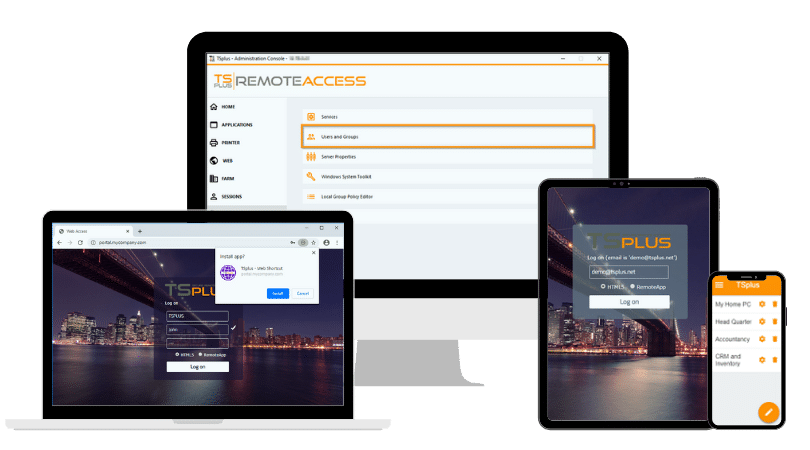¿Qué es el software de escritorio remoto RDP?
Discover in this article what RDP Remote Desktop Software is, how it works, its key features, benefits, use cases and security best practices.
Vuoi vedere il sito in un'altra lingua?
TSPLUS BLOG
Remote Desktop Protocol (RDP) es una herramienta esencial para los profesionales de TI, que permite la gestión y el acceso remoto a computadoras a través de una red. Comprender los números de puerto RDP es crucial para configurar conexiones remotas seguras y eficientes. En este artículo, profundizaremos en qué son los números de puerto RDP, cómo funcionan, configuraciones comunes y mejores prácticas para gestionar y asegurar estos puertos.
)
Before delving into the specific port numbers associated with RDP, it’s important to understand the protocol itself and why ports are critical to its operation.
Remote Desktop Protocol (RDP) es un protocolo de comunicación de red propietario desarrollado por Microsoft. Está diseñado para proporcionar acceso remoto a la interfaz gráfica de otro ordenador, permitiendo a los usuarios controlar esa máquina como si estuvieran sentados frente a ella. Esta capacidad es invaluable para el soporte de TI, la administración de sistemas, el trabajo remoto y la resolución de problemas, permitiendo a los usuarios autorizados acceder a servidores, estaciones de trabajo y máquinas virtuales a través de una red local o de internet.
RDP fonctionne sur un modèle client-serveur, où le client (utilisant généralement le client Microsoft Remote Desktop (mstsc.exe) sur Windows ou des clients équivalents sur macOS, Linux ou des appareils mobiles) initie une connexion à un serveur RDP. Le serveur RDP est généralement un système basé sur Windows exécutant les services de bureau à distance (RDS) ou un poste de travail configuré avec le bureau à distance activé.
El protocolo RDP admite una amplia gama de funciones más allá del uso básico de compartir pantalla, incluyendo el uso compartido del portapapeles, la redirección de impresoras, la transferencia de archivos, la transmisión de audio, el soporte para múltiples monitores y la comunicación segura a través de SSL TLS encryption. These features make it a versatile tool for both home users and enterprise environments.
Port numbers are an essential aspect of how network communication is managed. They are logical identifiers that ensure network traffic is directed to the correct application or service running on a system. In the context of RDP, port numbers determine how RDP traffic is received and processed by the server.
When an RDP client initiates a connection, it sends packets of data to the server’s IP address on a specified port number. If the server is listening on this port, it will accept the connection and begin the RDP session. If the port is incorrect, blocked by a firewall, or misconfigured, the connection will fail.
Port numbers are also crucial for security. Attackers often scan networks for systems using the default RDP port TCP 3389 como un punto de entrada para ataques de fuerza bruta o explotación de vulnerabilidades. Comprender y configurar correctamente los números de puerto es un aspecto fundamental para asegurar los entornos de escritorio remoto.
By default, RDP uses TCP port 3389. This port is well-known and universally recognized as the standard for RDP traffic. The choice of this port is rooted in its long history within the Windows ecosystem. When you launch a remote desktop connection using mstsc.exe or another RDP client, it automatically attempts to connect through TCP port 3389 unless manually configured otherwise.
Port 3389 est enregistré auprès de l'Internet Assigned Numbers Authority (IANA) en tant que port officiel pour le protocole de bureau à distance. Cela en fait à la fois un numéro de port standardisé et facilement reconnaissable, ce qui présente des avantages en matière de compatibilité, mais crée également une cible prévisible pour les acteurs malveillants cherchant à exploiter des systèmes RDP mal sécurisés.
Leaving the default RDP port unchanged TCP 3389 can expose systems to unnecessary risks. Cyber attackers frequently use automated tools to scan for open RDP ports on this default setting, launching brute force attacks to guess user credentials or exploiting known vulnerabilities.
Pour atténuer ces risques, les administrateurs informatiques changent souvent le port RDP pour un numéro de port moins courant. Cette technique, connue sous le nom de "sécurité par l'obscurité", n'est pas une mesure de sécurité complète mais constitue un premier pas efficace. Combinée à d'autres stratégies de sécurité—telles que l'authentification multi-facteurs, la mise sur liste blanche des IP et des politiques de mots de passe robustes—le changement du port RDP peut réduire considérablement la surface d'attaque.
However, it is important to document any port changes and update firewall rules to ensure that legitimate remote connections are not inadvertently blocked. Changing the port also requires updating the RDP client settings to specify the new port, ensuring that authorized users can still connect seamlessly.
Changing the RDP port number can significantly enhance security by making your system less predictable to attackers. However, this change must be made carefully to avoid inadvertently blocking legitimate Remote Access. Here’s how IT professionals can change the default port on Windows servers while maintaining secure and seamless connectivity.
Win + R
Remote Desktop Services (RDS) is a proprietary protocol developed by Microsoft. [, type]
regedit
, y presiona
Enter
.
PortNumber
, seleccionar
Decimal
, y introduce el nuevo número de puerto.
services.msc
find Remote Desktop Services, right-click, and choose Restart.
Changing the port number requires updating your firewall settings to allow incoming traffic on the new port. Failing to do so can block legitimate RDP connections.
Even after changing the RDP port, maintaining security is crucial. A secure Remote Desktop Protocol (RDP) configuration goes beyond simply changing the port number—it requires a multi-layered security approach. Here are best practices to protect your RDP connections from attacks, ensuring robust security while maintaining convenient remote access.
Network-Level Authentication (NLA) requires users to authenticate before a remote session is established, effectively blocking unauthorized users before they even reach the login screen. This is a critical defense against brute force attacks, as it only exposes the RDP service to authenticated users. To enable NLA, go to System Properties > Remote Settings and ensure the "Allow connections only from computers running Remote Desktop with Network Level Authentication" option is checked.
Pour une sécurité renforcée, restreignez l'accès RDP à des adresses IP ou des sous-réseaux spécifiques en utilisant le pare-feu Windows ou votre pare-feu réseau. Cette pratique limite l'accès à distance aux réseaux de confiance, réduisant considérablement l'exposition aux menaces externes. Pour les serveurs critiques, envisagez d'utiliser la liste blanche des IP et de bloquer par défaut toutes les autres adresses IP.
Establecer una Red Privada Virtual (VPN) para tunelizar el tráfico RDP añade una capa crítica de cifrado, protegiendo contra la interceptación y los ataques de fuerza bruta. Una VPN asegura que las conexiones RDP sean accesibles solo para usuarios autenticados conectados a la red privada, reduciendo aún más la superficie de ataque.
Regularly conduct port scans on your network using tools like Nmap or Netstat to identify open ports that should not be accessible. Reviewing these results helps detect unauthorized changes, misconfigurations, or potential security risks. Maintaining an up-to-date list of authorized open ports is essential for proactive security management.
Les problèmes de connectivité RDP sont courants, surtout lorsque les ports sont mal configurés ou bloqués. Ces problèmes peuvent empêcher les utilisateurs de se connecter à des systèmes distants, entraînant frustration et risques potentiels pour la sécurité. Voici comment les résoudre efficacement, en garantissant un accès à distance fiable sans compromettre la sécurité.
One of the first troubleshooting steps is to verify that the
porta RDP
is actively listening on the server. Use the
netstat
command to check if the new RDP port is active:
arduino:
netstat -an | find "3389"
If the port does not appear, it might be blocked by a firewall, misconfigured in the registry, or the Remote Desktop Services may not be running. Additionally, ensure that the server is configured to listen on the correct IP address, especially if it has multiple network interfaces.
Check both the Windows Firewall and any external network firewalls (such as those on routers or dedicated security appliances) to ensure the chosen RDP port is allowed. Make sure the firewall rule is configured for both inbound and outbound traffic on the correct protocol (typically TCP). Pour le pare-feu Windows :
Testing connectivity from another machine is a quick way to identify if the RDP port is accessible:
css:
telnet [dirección IP] [número de puerto]
If the connection fails, it indicates that the port is not accessible or is being blocked. This can help you determine if the problem is local to the server (firewall settings) or external (network routing or external firewall configuration). If Telnet is not installed, you can use Test-NetConnection in PowerShell as an alternative.
css:
Test-NetConnection -ComputerName [IP address] -Port [Port number]
These steps provide a systematic approach to identifying and resolving common RDP connectivity issues.
Pour une solution de bureau à distance plus complète et sécurisée, explorez TSplus Remote Access TSplus offre des fonctionnalités de sécurité améliorées, y compris un accès sécurisé au passerelle RDP, une authentification multi-facteurs et des solutions de bureau à distance basées sur le web. Conçu pour les professionnels de l'informatique, TSplus fournit des solutions d'accès à distance robustes, évolutives et faciles à gérer qui garantissent que vos connexions à distance sont à la fois sécurisées et efficaces.
Understanding and configuring RDP port numbers is fundamental for IT administrators aiming to ensure secure and reliable remote access. By leveraging the right techniques—such as changing default ports, securing RDP access, and regularly auditing your setup—you can significantly reduce security risks.

TSplus Accesso Remoto Prova Gratuita
Alternativa definitiva a Citrix/RDS per l'accesso desktop/app. Sicuro, conveniente, in locale/cloud.
Soluzioni di accesso remoto semplici, robuste e convenienti per professionisti IT.
La cassetta degli attrezzi definitiva per servire meglio i tuoi clienti Microsoft RDS.
 Contattaci
Contattaci